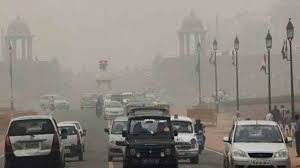 NEWDELHI: The national capital on Monday woke up with a thick layer of smog even as Delhi’s air quality dipped to ‘very poor’ levels, following the festival of lights Diwali, which India celebrated on Sunday. However, the air quality, although ‘very poor’, turned out better than the last three years, according to the data of the government’s air quality monitors.
NEWDELHI: The national capital on Monday woke up with a thick layer of smog even as Delhi’s air quality dipped to ‘very poor’ levels, following the festival of lights Diwali, which India celebrated on Sunday. However, the air quality, although ‘very poor’, turned out better than the last three years, according to the data of the government’s air quality monitors.
According to the System of Air Quality and Weather Forecasting And Research (SAFAR), the city’s overall air quality index (AQI) was predicted to be touching the ‘severe’ category between 1 am and 6 am on Monday, primarily due to firecracker emissions, unfavourable weather conditions, and increased stubble burning.
However, people in Delhi were in for a surprise with air quality sensors recording only a marginal increase in pollution levels even though people continued bursting crackers until late on Sunday night. The national capital’s AQI at PM 2.5 stood at 327 at 11 pm on Sunday, and it dipped to 323 at 3:30 am, around the time when it was expected to enter the ‘severe’ category as per SAFAR.
However, the overall AQI in Delhi is now increasing gradually with deteriorating air pollution. It increased to 340 at 8:30 am, as the weather department reported the occurrence of shallow fog. An AQI between 0-50 is considered ‘good’, 51-100 ‘satisfactory’, 101-200 ‘moderate’, 201-300 ‘poor’, 301-400 ‘very poor’, and 401-500 ‘severe’. Above 500 is ‘severe-plus emergency’ category.
Out of 33 air quality monitoring stations in the capital city, 25 of them recorded their AQI in ‘very poor’ category. Delhi’s air quality was, however, better than satellite towns of Ghaziabad (375), Greater Noida (356), Gurgaon (352) and Noida (375), according to Real-time Air Quality Index (AQI) data.
The levels of PM10 – a tiny particulate matter of diameter 10 or less than 10 microns that can enter deep into the lungs – had on Sunday reached as high as 515 micrograms per cubic metre in Anand Vihar.
In Wazirpur and Bawana, PM 2.5 levels had crossed the 400 mark. After last year’s Diwali, Delhi’s AQI had crossed the 600-mark, which is 12 times the safe limit. The AQI post-Diwali was 367 in 2017 and 425 in 2016.
Bureau Report
Leave a Reply